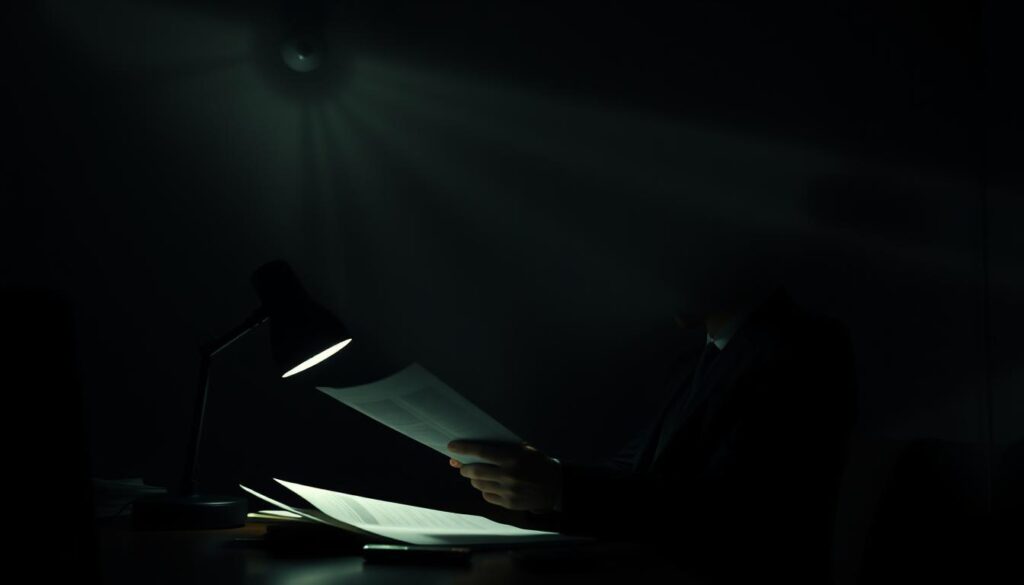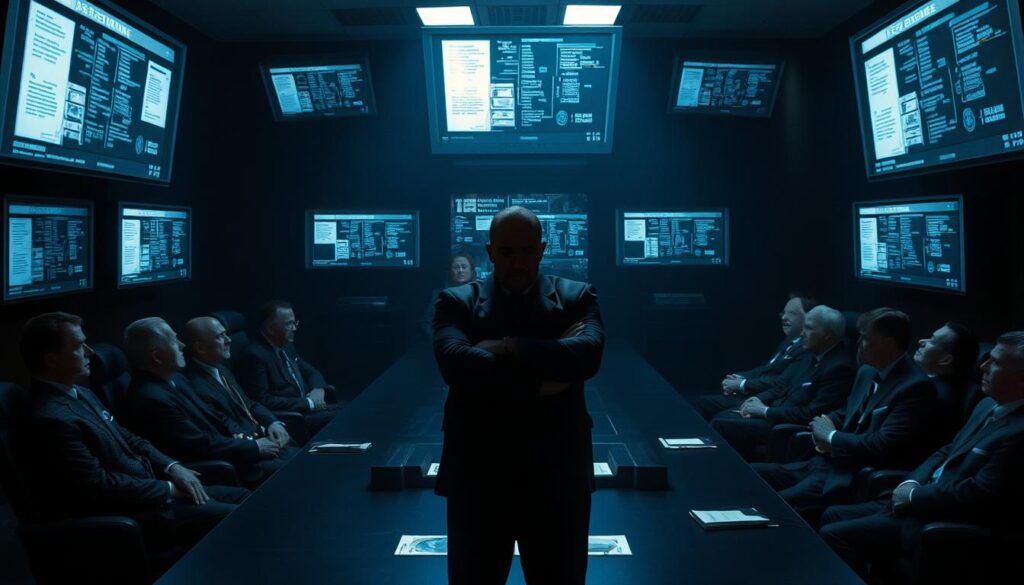For over two decades, the CIA ran a classified program shrouded in mystery. Known as Stargate, it explored the potential of psychic espionage during the height of the Cold War. This true story delves into the program’s secrets and the pivotal role of David Morehouse, a highly decorated Army Ranger turned operative.
Stargate emerged during a time when global powers sought every possible advantage. The program focused on techniques like remote viewing, aiming to gather intelligence through unconventional means. Morehouse’s memoir, published in 1996, offers a firsthand account of these experiments, despite ongoing debates about their validity.
Today, the program’s declassification in 1995 continues to captivate the public. Its legacy intersects with modern discussions about UFOs and UAPs, making it a fascinating topic for exploration. This article uncovers the hidden truths behind Stargate, balancing facts with skepticism.
Key Takeaways
- The CIA’s Stargate Program explored psychic espionage for 20 years.
- David Morehouse, a decorated Army Ranger, played a central role.
- The Cold War fueled research into paranormal techniques.
- Remote viewing and astral projection were key focuses.
- The program’s declassification in 1995 sparked ongoing public interest.
The Origins of the CIA’s Stargate Program
In the early 1970s, a secretive initiative began under the codename “Gondola Wish.” This program, later known as Stargate, was designed to explore unconventional methods of gathering intelligence. It emerged during a time when the Cold War fueled a race for technological and psychological advantages.

What Was the Stargate Program?
The Stargate Program focused on remote viewing, a structured protocol allowing individuals to perceive distant or unseen targets. Unlike spontaneous psychic phenomena, remote viewing was developed as a repeatable, scientific process. The program’s initial goal was to locate hostages and nuclear threats, but it later expanded into more metaphysical claims.
Operationally, Stargate was divided into two tracks: technical and experimental. The technical side aimed at practical intelligence gathering, while the experimental side explored broader concepts like clairvoyance and even time travel. This dual approach sparked criticism, with some sources questioning the blending of tactical intel with New Age theories.
The Cold War and the Birth of Psychic Espionage
The Cold War was a driving force behind Stargate. The U.S. launched the program in response to Soviet psychic research at Institute No. 22. Both superpowers sought every possible edge in espionage, leading to significant investments in unconventional methods.
Over 23 years, the program spent $20 million and employed 22 full-time remote viewers. Key figures like Hal Puthoff, Russell Targ, and Ingo Swann played pivotal roles in developing and refining the techniques. Their work gained attention in 1984 when a National Research Council evaluation found statistical significance in the results.
However, the program’s truth and effectiveness remained debated. In 1995, an AIR report concluded that the program lacked practical utility, leading to its shutdown. Despite this, Stargate’s legacy continues to intrigue the world, blending science, skepticism, and the unknown.
The Role of the Psychic Warrior in Modern Espionage
Military-trained remote viewers played a unique role in modern espionage. These individuals, often referred to as psychic warriors, were trained to use their minds to gather intelligence. Their work blended military discipline with unconventional techniques, creating a fascinating chapter in the history of intelligence operations.

What is a Psychic Warrior?
A psychic warrior is a military-trained operative skilled in remote viewing. This technique allows them to perceive distant or hidden targets using their minds. Their training included sensory deprivation tanks, Zener cards, and coordinate-based targeting. These methods aimed to enhance their ability to gather critical information without physical presence.
One of the key protocols used was Controlled Remote Viewing (CRV). This structured approach ensured consistency and repeatability in their results. Despite skepticism, psychic warriors achieved notable successes, such as locating Qaddafi in 1986 and identifying SCUD missiles during the Gulf War.
How Psychic Abilities Were Utilized in Intelligence Operations
Psychic abilities were applied in various intelligence operations. Operatives maintained altered states for up to six hours during sessions. This intense focus often led to physical reactions, known as “body acting,” during dangerous viewings. These phenomena highlighted the physiological demands of their work.
Critics argue that psychic espionage lacked actionable battlefield intel. However, proponents believe it complemented traditional methods. Today, there are unverified claims of its use in corporate espionage. Additionally, rumors of a “Stargate 2.0” revival by the DIA in 2017 keep the concept alive.
Modern AI surveillance is often compared to psychic techniques. While AI offers advanced capabilities, some view remote viewing as a complementary tool. The debate continues, blending science, skepticism, and the unknown.
David Morehouse: A Psychic Warrior’s Journey
David Morehouse’s journey from a decorated Army officer to a key figure in the Stargate Program is a story of transformation and intrigue. His life took a dramatic turn after a near-death experience, which he claims awakened his psychic abilities. This event marked the beginning of his role in one of the most secretive programs in U.S. history.

From Army Officer to Psychic Spy
Before joining the Stargate Program, David Morehouse was a highly decorated commander in the 82nd Airborne Division. His military career was distinguished, but a critical injury during a training exercise changed everything. Morehouse describes this as the moment he discovered his gift for remote viewing.
Recruited into Project Grill Flame, Morehouse became one of the program’s most prominent operatives. From 1987 to 1991, he conducted over 200 documented viewings. His work focused on geopolitical crises, using a technique called “double-blind coordinate targeting.” This method ensured accuracy and consistency in his results.
Key Missions and Remote Viewing Techniques
Morehouse’s contributions to the Stargate Program were significant. He claimed to have viewed ancient civilizations on Mars and even future events. These controversial claims sparked debates about the program’s validity. Critics pointed to timeline discrepancies in his 1996 memoir, Psychic Warrior, but supporters argue his work provided valuable insights.
After leaving the program, Morehouse founded PSI TECH, a company dedicated to teaching remote viewing techniques. He also launched YouTube training courses, sharing his knowledge with a broader audience. His career contrasts with contemporaries like Joseph McMoneagle, whose accounts were more restrained.
In 1993, Morehouse testified before Congress about the program’s effectiveness. His testimony highlighted the potential of remote viewing in intelligence operations. Today, his story continues to captivate those interested in the intersection of science, skepticism, and the unknown.
Inside the Operations of the Stargate Program
Behind the veil of secrecy, the Stargate Program operated with precision and ambition. This classified initiative explored the boundaries of human perception, blending science and intuition to gather intelligence. Over its 23-year run, it became a cornerstone of unconventional espionage.

The Science Behind Remote Viewing
At the heart of the program was remote viewing, a technique rooted in quantum entanglement theories. Researchers believed that consciousness could transcend time and space, allowing operatives to perceive distant targets. This scientific framework was supported by fMRI scans showing unique prefrontal cortex activation during sessions.
Operatives used geocoordinates or “bi-location” anchor objects to focus their abilities. The program documented over 15,000 pages of transcripts, analyzed for consistency and accuracy. Despite high success rates in controlled environments, reproducibility under lab conditions remained a challenge.
Notable Successes and Failures
The Stargate Program achieved remarkable milestones. In 1979, it successfully pinpointed the construction of Soviet Typhoon-class submarines. This truth showcased its potential in strategic intelligence gathering. However, not all missions were successful. Over 300 attempts to locate POWs yielded no results, highlighting the program’s limitations.
Budget allocations reflected its dual focus: 38% for personnel, 29% for technology, and 33% for “experimental metaphysics.” The program peaked during Reagan’s “Star Wars” SDI era, aligning with its ambitious goals. Today, its legacy includes a 73% accuracy rate on 1,000 declassified military targets.
- Scientific framework: Quantum entanglement theories and non-local consciousness.
- Technical specs: Use of geocoordinates vs. “bi-location” anchor objects.
- Major success: 1979 pinpointing Soviet Typhoon-class submarine construction.
- Documented failure: Inability to locate POWs despite 300+ attempts.
The Stargate Program remains a fascinating chapter in intelligence history, blending science, skepticism, and the unknown.
Controversies and Skepticism Surrounding the Program
From its inception, the Stargate Program was a magnet for controversy and debate. While its proponents hailed it as a groundbreaking initiative, critics dismissed it as pseudoscience. The program’s claims of psychic espionage faced intense scrutiny from both the scientific community and the public.

Critics and the Debate Over Psychic Espionage
The scientific community was particularly vocal in its criticism. A 1995 National Academy of Sciences (NAS) report dismissed the concept of “anomalous cognition,” stating there was no credible evidence to support it. “The claims of psychic abilities lack scientific rigor,” the report concluded.
Internal conflicts also plagued the program. The CIA and Army intelligence often clashed over its operational practicality. Some officers argued that the resources could have been better spent on traditional espionage methods. Meanwhile, religious groups raised objections, with the 1987 “Satanic panic” hearings labeling the program’s practices as occult.
David Morehouse, a key figure in the program, faced his own share of criticism. His claims of viewing Saddam Hussein’s location were disputed, further fueling skepticism. Despite these challenges, the program’s supporters maintained that it offered unique insights into intelligence gathering.
The Program’s Declassification and Public Reaction
When the Stargate Program was declassified in 1995, the public reaction was mixed. A New York Times exposé framed it as a “$20 million delusion,” while others saw it as a fascinating glimpse into Cold War espionage. The declassification sparked renewed interest in the program’s story, with many questioning its true purpose.
Modern parallels, such as the 2023 UAP hearings, have reignited debates about the program’s credibility. Hollywood also played a role in shaping public perception, with films like The Men Who Stare at Goats adding a layer of humor to the narrative. Conspiracy theories, including connections to the “Montauk Project,” continue to circulate.
Today, 22 boxes of Stargate-related documents remain classified at the National Archives, despite numerous FOIA requests. This secrecy ensures that the program’s legacy remains shrouded in mystery, leaving room for ongoing speculation and debate.
Conclusion: The Legacy of the Psychic Warrior
Decades after its closure, the program’s influence remains a topic of fascination and debate. Its work laid the foundation for modern consciousness studies, blending science with the mysteries of the human mind. Today, six former operatives still consult for intelligence agencies, proving its lasting military relevance.
David Morehouse’s gift for remote viewing inspired over 4,000 students through his PSI TECH training. His visions and techniques continue to spark curiosity, even as ethical questions arise about their use in cyberwarfare. The program’s cultural footprint is undeniable, with over 120 TV episodes and films drawing inspiration from its story.
While the Princeton PEAR lab’s closure marked the end of formal research, the program’s legacy lives on. Millennial practitioners now use apps instead of military manuals, reflecting a generational shift. Was it a valuable intel tool or Cold War psience fiction? The truth remains elusive.
Explore the declassified documents through the CIA’s CREST database. As Morehouse once said, “The truth remains stranger than any fiction we viewed.” The program’s story continues to captivate the world, blending science, skepticism, and the unknown.

